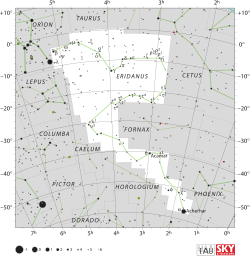Tau9 Eridani
| Tau9 Eridani (τ9) | |
 | |
| Observationsdata Epok: J2000.0 | |
|---|---|
| Stjärnbild | Eridanus |
| Rektascension | 03t 59m 55,48381s[1] |
| Deklination | -24° 00′ 58,3798″[1] |
| Skenbar magnitud () | +4,63[2] |
| Stjärntyp | |
| Spektraltyp | B9.5 V[3] |
| B–V | -0,13[2] |
| Variabeltyp | Roterande variabel av Alfa2 Canum Venaticorum-typ[4] |
| Astrometri | |
| Radialhastighet () | 25,5 ± 0,5[5] km/s |
| Egenrörelse (µ) | RA: +12,12[1] mas/år Dek.: +16,48[1] mas/år |
| Parallax () | 9,96 ± 0,22[1] |
| Avstånd | 327 ± 7 lå (100 ± 2 pc) |
| Absolut magnitud () | -0,44[4] |
| Detaljer | |
| Massa | 3,26[6] M☉ |
| Radie | 3,1[7] R☉ |
| Luminositet | 166[8] L☉ |
| Temperatur | 10 866[8] K |
| Vinkelhastighet | 30[9] km/s |
| Andra beteckningar | |
| τ9 Eridani, τ9 Eri, 36 Eridani, CD-24° 2022, FK5 2287, HD 25267, HIP 18673, HR 1240, SAO 169017. [10] | |
Tau9 Eridani (τ9 Eridani, förkortat Tau9 Eri, τ9 Eri) som är stjärnans Bayerbeteckning, är en dubbelstjärna belägen i den mellersta delen av stjärnbilden Eridanus. Den har en kombinerad skenbar magnitud på 4,63[2], är synlig för blotta ögat där ljusföroreningar ej förekommer. Baserat på parallaxmätning inom Hipparcosuppdraget på ca 10,0[1] mas, beräknas den befinna sig på ett avstånd på ca 327 ljusår (ca 100 parsek) från solen.
Egenskaper
Primärstjärnan Tau9 Eridani A är en blå till vit stjärna i huvudserien av spektralklass B9.5 V[3], som visar en mängd anomalier i dess absorptionslinjer för kisel i spektret. Den har en massa som är ca 3,3[6] gånger större än solens massa, en radie som är ca 3,1[7] gånger större än solens och utsänder från dess fotosfär ca 166[8] gånger mera energi än solen vid en effektiv temperatur på ca 10 870[8] K.
Tau9 Eridani är en enkelsidig spektroskopisk dubbelstjärna med en omloppsperiod på 5,9537 dygn och en excentricitet på 0,1.[11] Den är en Alfa2 Canum Venaticorum-variabel (ACV)[4] med en rotationsperiodicitet på 5,954 dygn.[12] Den genomsnittliga styrkan hos stjärnans magnetfält är 240,6 ± 91,0 G.[3]
Källor
- Den här artikeln är helt eller delvis baserad på material från engelskspråkiga Wikipedia, tidigare version.
Referenser
- ^ [a b c d e f] van Leeuwen, F. (2007), "Validation of the new Hipparcos reduction", Astronomy and Astrophysics, 474 (2): 653–664, arXiv:0708.1752 , Bibcode:2007A&A...474..653V, doi:10.1051/0004-6361:20078357.
- ^ [a b c] Mermilliod, J.-C. (1986), Compilation of Eggen's UBV data, transformed to UBV (unpublished), SIMBAD, Bibcode:1986EgUBV........0M.
- ^ [a b c] Bychkov, V. D.; et al. (April 2009), "Catalogue of averaged stellar effective magnetic fields - II. Re-discussion of chemically peculiar A and B stars", Monthly Notices of the Royal Astronomical Society, 394 (3): 1338–1350, Bibcode:2009MNRAS.394.1338B, doi:10.1111/j.1365-2966.2008.14227.x.
- ^ [a b c] Dubath, P.; et al. (2011), "Random forest automated supervised classification of Hipparcos periodic variable stars", Monthly Notices of the Royal Astronomical Society, 414 (3): 2602–2617, arXiv:1101.2406 , Bibcode:2011MNRAS.414.2602D, doi:10.1111/j.1365-2966.2011.18575.x.
- ^ De Bruijne, J. H. J.; Eilers, A.-C. (2012), "Radial velocities for the HIPPARCOS-Gaia Hundred-Thousand-Proper-Motion project", Astronomy & Astrophysics, 546: A61, arXiv:1208.3048 , Bibcode:2012A&A...546A..61D, doi:10.1051/0004-6361/201219219.
- ^ [a b] Shulyak, D.; et al. (September 2014), "Interferometry of chemically peculiar stars: theoretical predictions versus modern observing facilities", Monthly Notices of the Royal Astronomical Society, 443 (2): 1629–1642, arXiv:1406.6093 , Bibcode:2014MNRAS.443.1629S, doi:10.1093/mnras/stu1259.
- ^ [a b] North, P. (June 1998), "Do SI stars undergo any rotational braking?", Astronomy and Astrophysics, 334: 181–187, arXiv:astro-ph/9802286 , Bibcode:1998A&A...334..181N.
- ^ [a b c d] McDonald, I.; et al. (2012), "Fundamental Parameters and Infrared Excesses of Hipparcos Stars", Monthly Notices of the Royal Astronomical Society, 427 (1): 343–57, arXiv:1208.2037 , Bibcode:2012MNRAS.427..343M, doi:10.1111/j.1365-2966.2012.21873.x.
- ^ Abt, Helmut A.; et al. (July 2002), "Rotational Velocities of B Stars", The Astrophysical Journal, 573 (1): 359–365, Bibcode:2002ApJ...573..359A, doi:10.1086/340590.
- ^ ^ "tau09 Eri". SIMBAD. Centre de données astronomiques de Strasbourg. Hämtad 2016-10-13.
- ^ Pourbaix, D.; et al. (2004), "SB9: The ninth catalogue of spectroscopic binary orbits", Astronomy and Astrophysics, 424 (2): 727–732, arXiv:astro-ph/0406573 , Bibcode:2004A&A...424..727P, doi:10.1051/0004-6361:20041213.
- ^ Bychkov, V. D.; et al. (February 2005), "A catalog of stellar magnetic rotational phase curves", Astronomy and Astrophysics, 430: 1143–1154, Bibcode:2005A&A...430.1143B, doi:10.1051/0004-6361:20034563.
Externa länkar
Media som används på denna webbplats
Författare/Upphovsman: IAU and Sky & Telescope magazine (Roger Sinnott & Rick Fienberg), Licens: CC BY 3.0
IAU Eridanus chart


